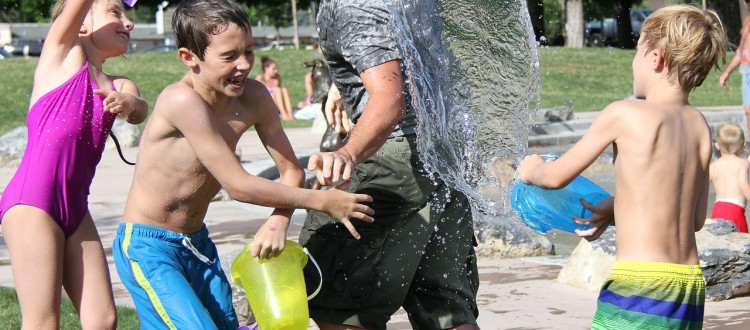
Among the parenting advice found in Ron Fournier’s Atlantic magazine article, "How Two Presidents Helped Me Deal With Love, Guilt and Fatherhood," is this: “Fathers and sons don't always know how to talk to each other, which is why we have sports.” It is brilliant in its simplicity and revealing in its essential truth.
But, it is also something more.
It is testament to the quintessential conundrum of raising children, boys and girls – how best, and how often, should we try to connect with them?
To begin with, “should” is a word that cognitive behavioral psychology frowns upon, as it suggests an urgency that, while it may be felt, is likely untrue if not unrealistic. Despite that warning, should, along with other “demand words” such as must, need, ought and have to, seem to easily commandeer a parent’s internal and external vocabulary, ratcheting up stress and creating misguided expectations for self-performance.
Fortunately for parents, Fournier followed that article with a just-released book published by Penguin Random House. “Love That Boy: What Two Presidents, Eight Road Trips, and My Son Taught Me About a Parent’s Expectations” does a deep dive into how we may unwittingly communicate expectations to our children that harm, rather than help, a healthy growth trajectory.
Understanding those dynamics, including parenting styles, communication patterns and parameters of acceptance, is an essential tutorial in behavior modification. But there is an equally important exercise we are well advised to pursue. What is it? Self-reflection on the expectations we either create for ourselves or grab from the carousel of ever-changing societal norms.
On the latter score, it’s often hard to keep up. While some advocate for more parenting, others call for less. Much like Goldilocks in her search for the right porridge, it may take time and trials to find the right parenting strategy for each family, each child.
Over the span of 30 years, we have ricocheted from what is now called “free-range” parenting to a virtual lockdown fueled by fear – and, to some degree, back again. To be sure, both approaches hold implications for how parents apportion and approach time with their children.
In her August 2015 Boston Globe article “When Did Parents Get So Scared?” Melissa Schorr explains, “Despite the eye-rolling of our elders and psychologists bemoaning that we are raising ‘a nation of wimps,’ I belong to a cohort of parents ruled by fear. Every mother I ask can recall with pinpoint accuracy a moment of stomach-churning panic when her child went momentarily missing – at a mall, in a hotel lobby, up an elevator, in the Children’s Museum. Rather than abating with time, the checklist of parental worries has only lengthened as our children have aged, like pencil marks ticking up their growth chart: from SIDS to chemicals in sippy cups, arsenic in apple juice to hormone-laden milk, Lyme disease and meningitis and measles outbreaks, vaccinating, not vaccinating, concussions and trampolines, whole grapes and popcorn, school shootings and cancer-causing sunscreen, overheated cars and negligent nannies, boogeymen kidnappers and friendly neighborhood molesters, and always, above all, the judgment of our fellow parents for failing to be as hypervigilant as they are.”
Unfortunately, that hypervigilance comes with a price tag.
Hanna Rosin, in her 2014 article “The Overprotected Kid,” cites “The Play Deficit,” an essay by Boston College psychologist Peter Gray that discusses “the fallout from the loss of the old childhood culture, and it’s a familiar list of the usual ills attributed to Millennials: depression, narcissism, and a decline in empathy.”
Gray presents data analyzed by Kyung-Hee Kim at the College of William and Mary that show “children have become less emotionally expressive, less energetic, less talkative and verbally expressive, less humorous, less imaginative, less unconventional, less lively and passionate, less perceptive, less apt to connect seemingly irrelevant things, less synthesizing, and less likely to see things from a different angle.” Along the same lines, he contends that “the rise in mental disorders among children is largely the result of the decline in children’s freedom. If we love our children and want them to thrive, we must allow them more time and opportunity to play, not less. Yet policymakers and powerful philanthropists are continuing to push us in the opposite direction – toward more schooling, more testing, more adult direction of children, and less opportunity for free play.”
Arguably, the command-and-control model ushered in by a faux crime wave against children generates increased anxiety and stress on families. That having been said, a more free-range approach pushes back to the center the question of how we choose to manage our time, and interact, with our kids.
It is at this intersection that parents face the daunting task of turning away from the inclination to perfect the art of parenting and toward a more balanced, less stressful paradigm of raising their children.
To that end, Kristin van Ogtrop, in her May 2015 TIME magazine article “Free-Range Parenting 2.0,” writes, “If I need any more encouragement to cut the apron strings, there is the study that came out last month in the Journal of Marriage and Family that shows the amount of time mothers spend with their children between the ages of 3 and 11 has no impact on how the kids turn out academically, behaviorally or emotionally … So now I’m convinced: if I want Junior to shed his anxieties and eventually go to college, I need to stop watching his every move. In fact, now that I know my three sons can be happy straight-A students who remember to chew with their mouths closed without constant vigilance from yours truly – well, I am out of here.”
Of course, an alternative to abandoning ship – which really wasn’t what van Ogtrop was advocating – is to just, well, relax.
In “Love That Boy,” Fournier writes, “Your children stand a better chance of being socially connected and successful adults if you ease off the structure, loosen up on the rules, and, whenever possible, simply let them play.” He goes on to say, “Just chill … We should re-fashion parenthood by tolerating pain, play, and failure. We should measure our children not by the mountains they conquer but by their efforts to climb.”
The same month that van Ogtrop’s piece appeared in TIME, Jaci Conroy documented in The Boston Globe the benefits of “slow parenting.” In the article she states, “Loosely, slow parenting means no more rushing around physically and metaphorically, no more racing kids from soccer to violin to art class. Slow parenting cherishes quality over quantity, being in the moment, and making meaningful connections with your family.”
In other words, being present.
Tellingly, in her essay “The Power of Presence,” psychologist Debbie Hall writes, “Presence is a noun, not a verb; it is a state of being, not doing. States of being are not highly valued in a culture which places a high priority on doing. Yet, true presence or ‘being with’ another person carries with it a silent power – to bear witness to a passage, to help carry an emotional burden or to begin a healing process. In it, there is an intimate connection with another that is perhaps too seldom felt in a society that strives for ever-faster ‘connectivity.’” She continues, “The power of presence is not a one-way street, not only something we give to others. It always changes me, and always for the better.”
Which brings us back to the Fourniers.
Recalibrating his expectations for Tyler and, perhaps more important, for himself, Fournier gained some important wisdom. “A parent’s love is unconditional,” he explains. “A parent’s satisfaction comes with caveats. This is an important distinction.”
It is. And satisfaction is a two-part equation: satisfaction with our child’s accomplishments and satisfaction with our parenting.
Fournier goes on to say that parenthood is “the last chance to be the person we hoped to be. We want to get it right. We want it to be perfect, that’s the problem. It’s a hard slog between aspiration and realization.” He also speaks to self-chastisement for getting it wrong. Yet, in the end, Fournier explains, “There is some comfort in the discovery that I am not alone. I found scores of other parents struggling along the path to acceptance, where love and fear and self-regard blind us to the subtle difference between guiding and pushing our children.”
For his part, Tyler, reflecting on the book project and the eight aforementioned road trips, told his dad, “Just write that we like to spend time together. That’s a big deal for a kid like me.”
In truth, presence is a big deal for all kids.
Last but not least, what did Tyler’s mom Lori have to say? “The easy part of parenting is the dreams we have for our kids; we all have them. The hard part, the goal of all of this, is learning to accept and love the kids you have.”
Is it too much to suggest we apply the same metrics to the parents we are?
Kids and parents, both in the ballpark of perfect.



























